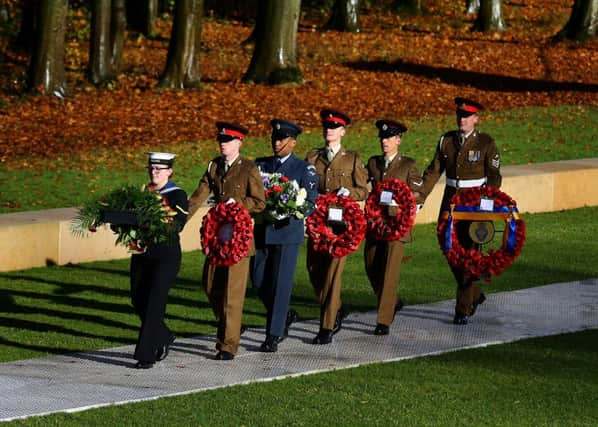100 years after guns fell silent at the Somme, the world pauses to remember


The British and French national anthems were sung at the Thiepval Memorial to the Missing heralding the end of the bloody four-and-a-half month offensive which started on July 1 1916.
To mark each day of the battle, a daily service has been held at the towering monument, which is inscribed with more than 72,000 soldiers’ names whose bodies were never recovered or identified.
Advertisement
Hide AdAdvertisement
Hide AdIn July, an international service attended by figures including the Prince of Wales, the Duke and Duchess of Cambridge, Prince Harry and then prime minister David Cameron was held marking the 100th anniversary of the battle’s beginning.
A more low key ceremony was held today to commemorate the centenary of the final day of the battle, which was fought by 60 nations from across the British Empire and Europe across a 15-mile front in northern France.
Guests including the British ambassador to France, Lord Llewellyn of Steep, braved downpours during the service which was led by Bishop James Newcome, the Royal British Legion national chaplain.
The Rev Stephen Hancock, chaplain to the Royal British Legion Somme branch, said: “The trees and fields today mask the horror that once came here. I pray God that is never repeated and I pray God that the people who died are remembered.”
Advertisement
Hide AdAdvertisement
Hide AdThe Last Post was followed by a two minutes’ silence and wreath laying by figures including Earl Howe, deputy leader of the House of Lords. A lone piper led a military escort of the wreaths to the nearby memorial where they were laid.
Liz Sweet, director of external relations for the western Europe area for the Commonwealth War Graves Commission, said that the Thiepval Memorial to the Missing was the largest CWGC monument in the world.
Mrs Sweet told those gathered: “Every grave here, every name, is an opportunity to reflect on the battles of the Somme and their human cost.”
The British Army suffered almost 60,000 casualties on the first day of the battle alone, marking it out as the bloodiest day in British military history. And more than a million men were killed or wounded on both sides over the course of the 141 days.
Advertisement
Hide AdAdvertisement
Hide AdAmong the worst hit were the “pals” battalions - volunteer units with limited fighting experience. Many were told to walk slowly across no man’s land, resulting in high numbers of fatalities as troops headed into German machine gunfire.
The Right Reverend Nigel McCulloch, head of remembrance at the Royal British Legion and a former Bishop of Wakefield, said those who fought had left an “enduring legacy” across the UK and Commonwealth.
He said: “Throughout the First World War centenary, the legion has led the nation in remembering the men whose sacrifice has come to symbolise the tragic scale and futility of modern industrialised warfare.
“The last day of the Somme is a moment to reflect on the collective sacrifice of all those who fought and fell in such tragic numbers between 1 July and 18 November, 1916.”
Advertisement
Hide AdAdvertisement
Hide AdEarlier this month it was announced that hundreds of harrowing first-hand accounts, mostly written by the Tommies who went over the top on July 1 1916, would be made public for the first time.
Among those in the collection was that of Private John Kirkham, a 20-year-old in the 20th Battalion Manchester Regiment in 1916, who described attacking a German soldier with a “knobkerrie”, a steel-headed club used in hand-to-hand fighting.
Another correspondent, Lance Corporal Charles Bartram, 23, who had been at the front with his mortar unit for a matter of weeks, described seeing his senior officer killed by a sniper in front of him as they waited to go “over the top”.
Bartram, 23, a mine worker from Darfield in South Yorkshire, was serving in the 94th Brigade Trench Mortar Battery on the Somme.
He had been in France just a couple of months when the battle started.